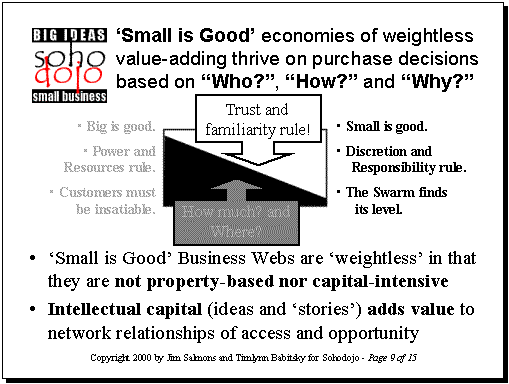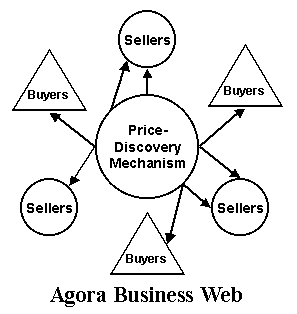![]() Complaint? Irritation? Suggestion?
Complaint? Irritation? Suggestion?
Tell us, please.

An Applied R&D Lab Serving Solo and Family-based Entrepreneurs in Rural and Distressed Urban Communities
The Nanocorp Primer #5
Nanocorps in the Dream Society
How 'Small is Good' Business Webs Will Compete in the Story-driven Marketplaces of the 21st Century
| << Previous slide] [Next slide >> |

|
| << Previous slide] [ Back to first slide ] [Next slide >> |
| B-Web Resource | |

|
|
|
Tapscott, Ticoll and Lowy's |

The Yin-Yang of e-Commerce Engines
In the first installment of The Nanocorp Primer, we described the challenge of extending the 'ride' on Spaceship Earth as a 'dynamic tuning' between the inseparable oppositions of 'Small is Good' and 'Big is Good' organizing principles within our Capitalist economic system. Neither 'side' being right nor wrong, just different. Each fulfilling a value-proposition which ensures its survival.
| Notable Quotes... | |

|
|
| "The new economy is a molecular economy. The old corporation is being disaggregated, and replaced by dynamic molecules and clusters of individuals and entities that form the basis of new economic activity." | |
|
Don Tapscott in The Malaysia Star |
We also recognized that the 'Big is Good' dominance of the Industrial Era economy has skewed the balance away from 'Small is Good' to a preponderance of 'Big is Good' thinking underlying our strategic approach to business. This dominant assumption, that 'Big is Good' is essential to successful business, has given us a blindspot when it comes to designing the e-commerce engines underlying our web-based business ventures.
It is the goal of the Sohodojo TechSIG research and development program to develop, and make freely available, Open Source technologies which leverage and enhance 'Small is Good' organizing dynamics within networks of collaborating free agent nanocorps and their dejobbed small businesses. In addition to capitalizing on the unique dynamics of our business webs, we will leverage market and broad social trends with the potential to increase the competitive advantage of 'Small is Good' business webs in the global network economy.
'Big is Good' e-Commerce Engines and the 'Blindspot'
Before we enumerate some initial design points for an e-commerce engine to support 'Small is Good' business webs, let's look at Don Tapscott's taxonomy for understanding the various types of business webs. We'll see how an implicit 'Big is Good' assumption underlying Tapscott's taxonomy creates a 'blindspot' that we'll seek to illuminate. Tapscott, Ticoll and Lowy, in Digital Capital, describe five basic types of business web:

- Agora
- Aggregation
- Value Chain
- Alliance
- Distribution Network
While real world instances are often hybrids of these business web archetypes, the simplifying assumption of distinguishing the distinct types can help us theorize about these business models. For this discussion, let's simplify further by focusing on one type of business web, the Agora.
Tapscott uses the term agora to describe markets where buyers and sellers meet to freely negotiate and assign value to goods. According to Tapscott, "An Agora facilitates exchange between buyers and sellers, who jointly 'discover' a price through on-the-spot negotiations. Price discovery mechanisms include one-to-one haggling, multiparty auctions and exchanges." (Digital Capital, p. 30-31)
| Agora B-Web | |
|---|---|
| Main theme | Dynamic pricing |
| Value proposition | Liquidity - converting goods into a desirable price |
| Customer role | Market player |
| Knowledge focus | Timing - Market Intelligence |
| Key process | Price discovery |
| Examples | eBay - Yahoo! classifieds - Priceline - AdAuction - NASDAQ - MetalSite - FreeMarkets |
Tapscott and his coauthors provide a table which details six key features for each of the five types of business web. The key features for the Agora are listed in the table at left.
Notice the implicit assumptions which are consistent with a 'Big is Good' approach to business. The main theme, value proposition, knowledge focus and key process features are grounded in 'How Much?' and 'Where?' purchase decision drivers. We should not be surprised to see that auction models dominate the examples cited.
We can make this underlying assumption explicit. Let's expand Tapscott's table to show the distinction between key features of 'Big is Good' Agora and 'Small is Good' Agora business webs.
In the expanded table, notice how the 'Who?', 'How?' and 'Why?' purchase drivers of 'Small is Good' business webs naturally resonate with the story-driven, imagination-based and emotionally-satisfying markets of the Dream Society.
| 'Big is Good' Agora | 'Small is Good' Agora | |
|---|---|---|
| Main theme | Dynamic pricing | Dynamic storytelling |
| Value proposition | Liquidity - converting goods into a desirable price | Meaning - wrapping goods/services with imaginative stories |
| Customer role | Market player | Coauthor storyteller and character |
| Knowledge focus | Timing - Market Intelligence | Trust - Community Building |
| Key process | Price discovery | Story discovery |
| Examples | eBay - Yahoo! classifieds - Priceline | MicroAid.net (now) Squirrelfeeders.com (to be) |
Each key feature of the 'Small is Good' Agora exploits the story-driven dynamics of a Dream Society marketplace.
In the pricing-driven 'Big is Good' Agora, disintermediation rules. The most desirable prices are more likely to be discovered when as many middlemen as possible are pushed out of the market transaction.
In the story-driven 'Small is Good' Agora, open mediation rules. The customer wants as many middlemen as are needed or desired to 'make a good story' when composing a 'purchase scenario'.
For example, in a story-driven purchase scenario, our customer may buy a squirrel feeder from her aunt's Seniors' Club which funds its intern scholarships through an alliance with Squirrelfeeders of Durham. Squirrelfeeders of Durham's at-risk teenage entrepreneurs build their feeders through a revenue-sharing arrangement with a local Job Skills Development Center which provides the woodshop, etc.
At the time of purchase, each participant's benefit from the proposed transaction is 'woven' into a dynamic, emotionally-fulfilling story which wraps the actual product or service purchase. In such an open, story-driven value chain, the intermediaries have 'story-building' value rather than being 'expensive excess baggage'.
As we have described above, Tapscott, Ticoll and Lowy have too-narrowly limited themselves to the 'Big is Good' side of Capitalism. By opening our eyes to the 'other side', we can identify business model designs which are uniquely suited for competing in the story-driven markets of the Dream Society.
Game-based e-Commerce Dynamics and the 'Blindspot'
The implicit bias toward 'Big is Good' value assumptions skews our application of gaming dynamics within business models, too.
|
Great Game Great Story |
|

|
|
|
The Dream Society came early to the employee-owners of Springfield Remanufacturing Corp. They learned to play the Great Game of Business by opening up their books and their minds. Read the story or visit the Great Game of Business web site to see a prime example of a great business built on a Great Story! |
Humans are gameplayers just as naturally as we are storytellers. Jensen's Dream Society reminds us that our gaming tradition ties us as much, if not more, to our hunter-gatherer heritage as it does to our more recent Industrial/Organization Man culture.
In marketplaces which value pricing and survival through market domination, it is not surprising that our application of game dynamics emphasizes team-oriented, scoring-based game forms.
The turn-around experience of the Good Folks at Springfield Remanufacturing Corp led its spiritual and operational leader, Jack Stack, to tell us the tale of Open Book management in the Great Game of Business. By turning its internal accounting systems into an overt, score-driven game, Stack's company of employee-owners harnessed the inner spirit of competition and pride in self-made success.
As exciting and important as 'playing the game' can be, it is rather apparent that the 'Great Game' approach to business is skewed toward team-play and 'score-able' scenarios. This is not too surprising as these aspects of gaming are consistent with the prevalent 'Big is Good' approach to business.
We need only survey the range of computer-based video games to see that there is a whole range of gaming forms that are available to us for stimulating business. Two genres which are wildly successful in the video game market that have implications for playing in the emerging story-driven markets are exploratory learning simulations, such as Maxis' SimCity, and role-based adventures, such as Origin's Ultima.
Both gaming forms, the exploratory simulation and the role-based adventure, have reputations for being 'addictive' gaming experiences. In both cases, this 'stickiness' which keeps the gamer involved has to do with the players' active imaginations dynamically building stories around the extended play experience.
While team-based and scoring-driven game forms have utility in both 'Big is Good' and 'Small is Good' business models, we predict that 'Small is Good' business webs will more effectively capitalize on the exploratory learning and adventure-driven gaming forms. This 'extra bit' of competitive advantage comes from the natural affinity of these gaming forms to the story-driven markets of the Dream Society.
Design Points for Story-driven e-Commerce Engines
Now that we have considered the underlying nature and blindspots of 'Big is Good' approaches to business, let's turn our attention to imagining the design points for an effective 'Small is Good' e-commerce engine. Based on insights gained from the analysis above, we propose that our 'Small is Good' story-driven e-commerce engine will have the following characteristics:
- Open Book in nature
- encourage 'story-forming' - hidden agendas and 'missing pieces' ruin good stories
- support open mediation rather than disintermediation - as many characters as it takes to tell a good story
- a fine-grained financial transaction-space
- secure-yet-visible to encourage 'story-forming'
- purchases are customer-written 'scenes' in an engaging, emotionally-rewarding story
- offer a wide range of gaming forms
- the customer role is not fixed - by sharing the storyteller point of view, customers become ensemble players in a persistent web of trust relations
- teaming is important, but more likely to be dynamically composed from the customer's point of view to support the story
- workers and customers become increasingly indistinguishable as they dynamically become engaged in each others' stories
|
TechSIG Eye On |
|
|
• Pelle Braendgaard is 'bearing' it all as the leader of London-based NeuDist.org. Their bold plan is to support secure, fine-grained 'small business' collaborations based on a generalization of object-oriented concepts related to responsibility-driven design. 
• ERights.org, home of E, offers a secure distributed object platform and scripting language for writing Capability-Based Smart Contracts. This choice, quality stuff, along with Pelle's ideas and software at NeuDist.org, are pieces of the financial 'transaction space' essential to 'Small is Good' business webs. |
This initial list of design points clearly demonstrates that a 'Small is Good' Story-driven e-Commerce Engine will be qualitatively different from current e-commerce offerings which contain implicit assumptions of 'Big is Good' and lack of disclosure. Current e-commerce solution offerings are simply blind to the dynamics which will shape the imagination-based, emotionally-fulfilling, story-driven consumer behavior in the emerging Dream Society.
The Sohodojo TechSIG research and development program will address this hole in the technology support for 'Small is Good' business webs. We are designing, and will make freely available, an Open Source e-commerce platform which is consistent with the design points described above. If you would like to participate in this important and interesting story... talk to us.
[ Back to top ] [Next slide >>
Slide text
'Small is Good' economies of weightless value-adding thrive on purchase decisions based on 'Who?', 'How?' and 'Why?'
- 'Small is Good' Business Webs are 'weightless' in that they are not property-based nor capital-intensive
- Intellectual capital (ideas and 'stories') adds value to network relationships of access and opportunity
[ Back to top ] [Next slide >>
